
Although Roth probably has far remoter origins - a legend claims that Saint Willibrord destroyed an age-old Celtic place of worship and built a Christian chapel in its place - the village is first mentioned in one of Pope Hadrian IV´s documents in the year 1154.
The Templars
About the year 1228 Count Henry I of Vianden presented the legendary Templars with the newly-built parish church of the neighbouring village of Roth and along with it a fortified manor and extensive property. For almost 100 years the Templars owned the tithe and used this income to keep their castles, ships and troops in Palestina going. After the loss of the Holy Land, however, this military order of knights became superfluous and so, at the French King Phillip IV´s instigation, Pope Clement V abolished it at the council of Vienna of 1312. Phillip had accused the Templars of heresy and other atrocities. Legend then transformed the Templars into idol-worshipping robber barons. More recent historical research, however, show that these allegations prove untenable and that they were only a means to an end, since the King had high debts with the Templars and wanted to acquire their riches. Thus, you could still come across an undiscovered Templars´ treasure somewhere.
| The Knights of St John and the Knights of Malta (Hospitallers) | |
| In Roth, as in most other places, the property of the Templars was transferred to the Order of the Knights of St John who were devoted to nursing. For a while the commendam in Roth, and also other houses of the Order in Kronenburg (Eifel), Sobernheim, Hangenweissen (near Speyer), Altmühlmünster, Regensburg and Freiburg (Switzerland) all came under the authority of one single commander. The running of the commendam was placed in the hands of an administrator, who lived in the house. From 1530 onwards the Order of the Knights of St John, which had been given the island of Malta as its headquarters by Emperor Charles V, was more commonly known as the Order of the Knights of Malta (Hospitallers). Nowadays, this name refers to the Catholic branch of the Order, whereas the Order of the Knights of St John refers to its Protestant branch. In the course of the next centuries the Hospitallers massively rebuilt the commendam. | 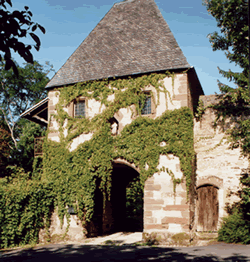 |
| In the 16th century they first built the hexagonal tower with its skilful and elaborate winding staircase in the Renaissance style. In 1610 they built the fortified gatehouse which was meant to protect the commendam from the raids of bands of robbers. | |
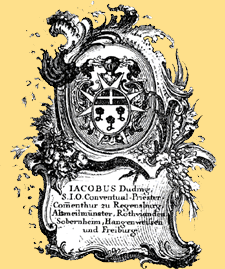 |
The residential building, dating from the 13th century, was drastically renovated in the 17th century. About a 100 years later, however, in the year 1733, the house had become so dilapidated that the then commander Jacob Duding (1707-1766) had it pulled down except for the tower and its staircase and then had it rebuilt in the Baroque style. Many of the details on this new building, such as the beautiful Baroque main entrance with the coat of arms of Jacob Duding and the three open fireplaces in the house date from this period. In 1795 the commendam was occupied by the French Revolutionary Troops and it was dispossessed like all other Church property.
|
The André family
On December 31,1797 the son of the last administrator under the Hospitallers, the notary and mayor of Vianden, Franz Julian André (1773-1859) acquired the castle and all its possessions of Roth, Obersgegen, Körperich, Geichlingen and Vianden for the price of 206,000 livres. In the outline agreement set up in the treaty of Vienna the lands that used to belong to the county of Vianden but situated east of the rivers Our and Sauer were now bestowed onto Prussia. Thus Roth became part of the Prussian Province of the Rhine. In the course of the 19th century the André family played a not unimportant role in the political and cultural lives of the region. Philipp Christian André (1817-1892), as a Prussian citizen, was a member of the Prussian Parliament from 1855 to 1867. His brother Karl-Theodor (1822-1883) had chosen to have the Luxemburgian citizenship and was a member of the Luxembourg Parliament from 1848 to 1854 and from 1859 to 1874. He also published late Romantic poetry under the pen name Sempronius.
Victor
Hugo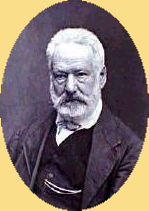
The brothers Philipp Christian and Karl-Theodor had made friends with the most famous of 19th century French authors, Victor Hugo (1802-1885), who visited Schloss Roth several times during his 11-week stay in Vianden in the summer of 1871. In his diary Victor Hugo writes: August 4th, 1871: Having arrived at the Prussian border, we met with M. (Philippe) André of Roth. He asked us to pay him a visit. I did visit Roth; the old Romanesque church with its surprising 9th century apse and its galleries of interposed round arches. Here the Romanesque is still almost Roman. Next to it, in the outside wall, an 11th century gravestone. The steeple dates from the 12th century. The castle is a former commendam of the Templars and the Hospitallers. It is still in very good repair. Inside some old traces, stone fireplaces, a winding staircase cut in stone; outside several inscriptions, on the gate you can still see the impact of a battery that the Marshall de Boufflers had set up on the opposite hill. The castle overlooks two valleys of the river Our. It is very beautiful.
Until the outbreak of World War Two the descendants of the André family continued to live in Roth.
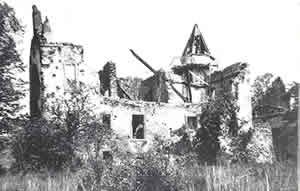 Destruction and reconstruction
Destruction and reconstruction
During the Battle of the Bulge (1944 to 1945) the residential building and the stables were badly damaged. The widow of the last owner did not have the necessary means to rebuild the castle and so it slowly dilapidated.
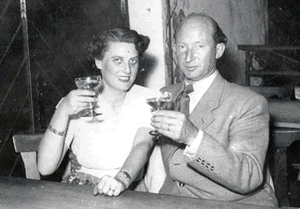 On October 23rd 1958 Hubert Joseph Eggen (1904-1980) and his wife Gertrud Eggen-Neuefeind (1917-1985) acquired the ruin. After several years of reconstruction the castle was finally back to its former glory. In 1985 Ton Eggen succeeded his parents and is now continuing their work.
On October 23rd 1958 Hubert Joseph Eggen (1904-1980) and his wife Gertrud Eggen-Neuefeind (1917-1985) acquired the ruin. After several years of reconstruction the castle was finally back to its former glory. In 1985 Ton Eggen succeeded his parents and is now continuing their work.
![]()